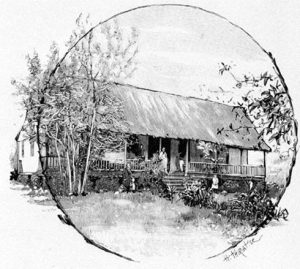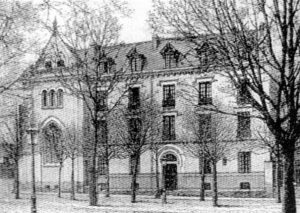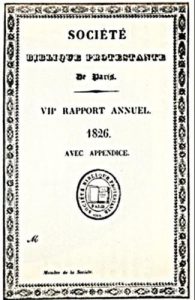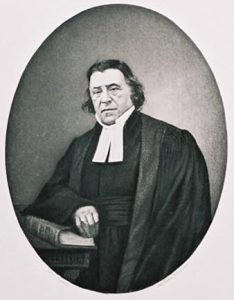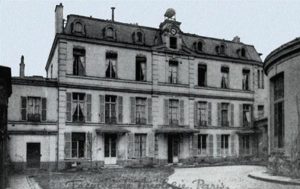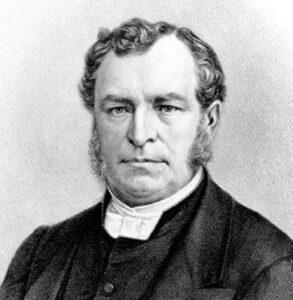Overseas missions
- The Society for Evangelical Missions (currently DEFAP)
The Society for Evangelical Missions amongst non-Christian peoples was created in Paris in 1822. Its first mission was established in Lessouto (currently Lesotho) in South Africa. Later, missions developed in the Pacific area – especially in Tahiti – in Zambezi, and with far greater difficulty in Gabon (formally French Gabon and then Brazzaville), in Senegal and in Kabylie. Under the Second Napoleonic Empire, an attempt was made to establish missionary work in China but it was short-lived.
In its early days, the Society followed in the footsteps of the English, Dutch and Swiss Missionary Societies, active as early as the beginning of the nineteenth century because of the overseas expansion of their respective countries. The Mission Society took over from any of these Societies according to change of protectorates. Its task was made difficult in the French colonies where Catholic missions were already established.
The Lessouto (Lesotho) mission was considered not only as a pioneering organisation but also as a model. Around the 1890s, it includes 128 stations, 81 evangelists, 57 evangelist primary school teachers and 103 indigenous teachers who assisted the missionaries. The number of adult Christians who had an influence on the community was estimated at 12,443 for a population estimated at 49,772 people. Logistic support consisted of 129 primary schools, a teachers’ training school, a girls’ high school, a technical school, a bible school and a theological school. The mission published a monthly, la petite lumière du Lessouto. Such a success had a visible impact in Zambezi.
The specific nature of missionary work required the missionaries to get special theological, as well as practical, training. Both were given in Paris.
Such a costly undertaking implied the help of many people. The Mission Society benefited from numerous donations and bequests and these made it possible to build the House of Missions (currently the DEFAP) in 1882, at 102, Arago Boulevard in Paris.
In addition, many wives of pastors and missionaries were engaged in helping the Society to grow. An Auxiliary Committee of the Parisian Ladies was created in 1830 and the number of its members kept increasing. In 1866, this Committee offered to educate “child missionaries”. The idea was to bring children to France for two or three years and give them a good education before returning to their home country to evangelize it. An annual fund raising charity sale was organised ; and this tradition was kept up until 1990, though with a different aim.
The Society was particularly sensitive to the issue of slavery and tried to deal with this problem either by clear reference to human rights, or else, at times, in more paternalistic ways.
- Service in aid of fugitive slaves from Saint-Louis, Senegal
This organisation was independent from the Mission Society ; its aim “is to save and evangelize the slaves who sought refuge in Senegal in order to escape the barbaric treatment of their owners ; it is to select the brightest and the fittest amongst them in order to bring them up in France as skilled craftsmen, primary school teachers or, if God calls them, as missionaries so that one day , Senegal, which is so inhospitable to Europeans, might be evangelised by its own children” (secourir et évangéliser les esclaves qui, maltraités à l’intérieur, se réfugient au Sénégal pour échapper au traitement barbare de leur possesseurs ; choisir parmi ces fugitives les jeunes gens les mieux disposes et les plus intelligents pour les élever en France et en faire des artisans habiles, des instituteurs et, si Dieu les appelle, des missionnaires, afin qu’un jour le Sénégal, cette terre si inhospitalière pour les Européens, puisse être évangélisée par ses propres enfants – Dictionnaire des oeuvres protestantes).
Home missions
Alongside overseas missions, a number of home missions offered a great variety of services.
- The Evangelical Society of France, created in 1833 by Victor de Pressensé, aimed at finding places for Protestant worship. In the nineteenth century, 24 Reformed churches, 8 free churches, 2 Methodist churches and one church of the Augsburg confession were opened. The Society also strongly encouraged itinerant evangelization.
- The Central Society for Evangelization, founded in Bordeaux in 1835, and in Paris in 1847, encouraged the founding of theological schools. It also provided “Protestant emergency care” to those who, in hospitals or elsewhere, did not have access to it.
- In 1854, during the Crimean war, the Committee for the Evangelization of Protestant military personnel was founded. As a result, the Protestant military chaplaincy became officially recognized ; it has been active ever since.
It is worth mentioning that within the framework of home missions, the French Society for the Evangelisation of Israel was founded in 1888. This service took up the activities of the Society of the Friends of Israel, founded in Strasburg with English funds in 1835. Its (somewhat disturbing) aim was to evangelize Jews of French descent. The Society published a periodical called the “Friends of Israel” (Les amis d’Israël).

